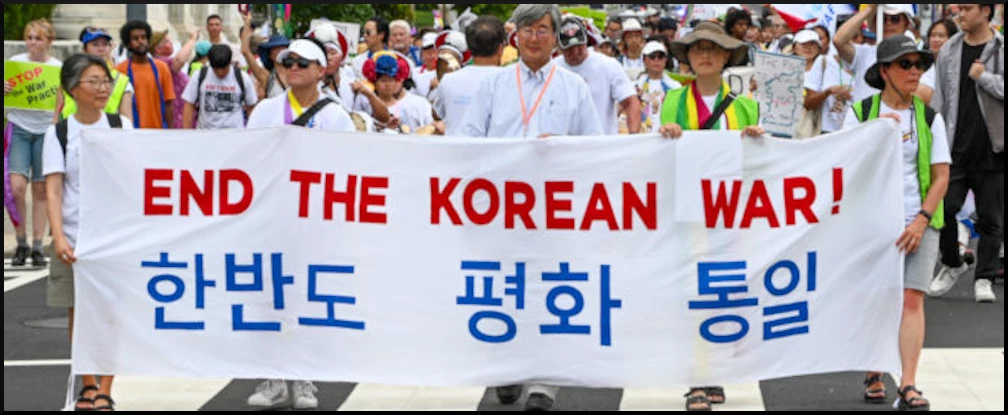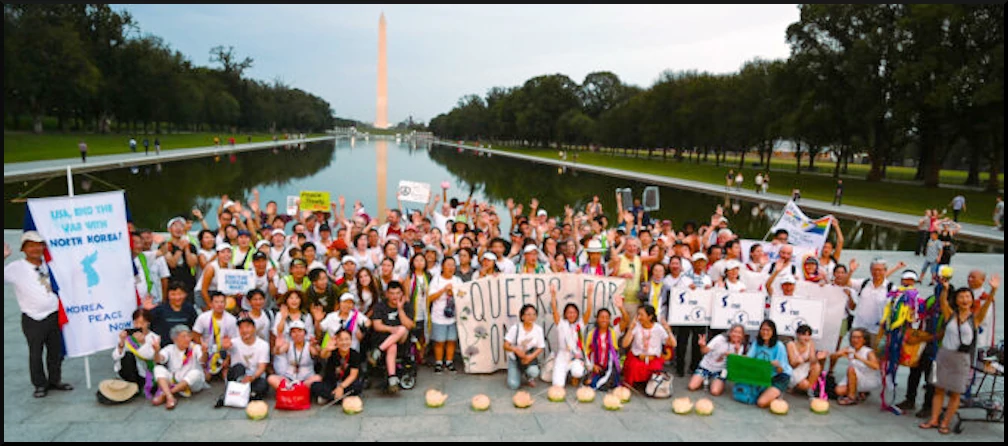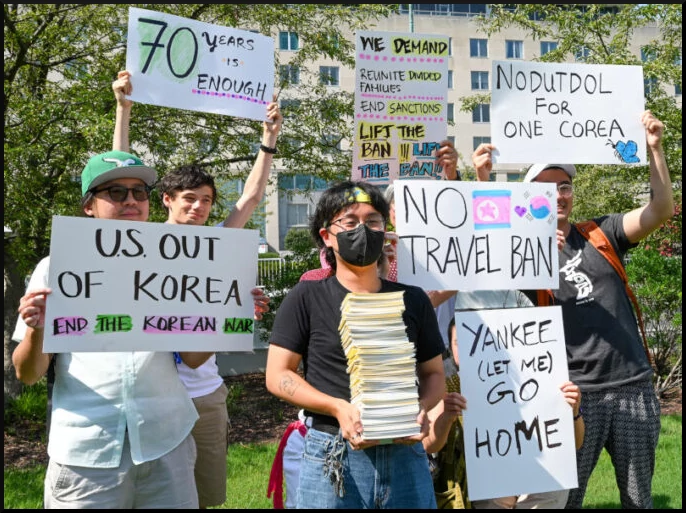by Joe Piette, published on Workers World, August 2, 2023
Washington D.C.~ A National Mobilization to End the Korean War drew hundreds of people to several events here on July 27 and 28.
July 27 was the 70th anniversary of the 1953 armistice that ended combat in the Korean War. That agreement — among the Democratic People’s Republic of Korea (DPRK) in the north, the People’s Republic of China and the United States — to suspend fighting was expected to be temporary, in anticipation of negotiations for a peace treaty after three months. The Republic of Korea (ROK) in the south was not a signatory of the truce.
Since then, however, the U.S. has stationed tens of thousands of troops in South Korea, tensions remain high, and to this day a peace agreement has never been reached.
The 70 years of U.S. (and more recently, U.N.) sanctions, isolation and military threats have denied the DPRK’s population the necessities of life, prevented the reunification of Korea and prolonged the state of war. It is time to end the Korean War and reunite Korean families, demilitarize the Korean Peninsula and reduce the risk of nuclear war in northeast Asia.
The stated goal of the Korea Peace Action Coalition organizers is to urge “President Biden and Congress to support a formal end to the Korean War. In Congress, we’re asking for the support of H.R.1369, the Peace on the Korean Peninsula Act, which calls for diplomacy with North Korea to formally end the Korean War, a comprehensive review of travel restrictions to North Korea, and the establishment of liaison offices in the U.S. and North Korea.”
End the Korean War now!
A news conference on July 27 in front of the U.S. Capitol featured a broad array of activists and organizations: Christine Ahn, Women Cross DMZ; Joy Gebhard, Divided Family Member; Rick Downes, Coalition of Families of Korean & Cold War POW/MIAs; Lt. General (Retired) Daniel P. Leaf, U.S. Air Force; Joyce Ajlouny, American Friends Service Committee; Hana Marie Kim, 30 Under 30 activist and high school student; and Barbara Lee, U.S. Congress member from California.
Following the press event, an emotional Han ceremony at the Foundry United Methodist Church gave the many participants of Korean ancestry an opportunity to express and manage the complex emotions of sorrow, resentment, grief, sadness and hope that afflict many members of families separated during the Korean War and the following seven decades of a divided Korea.
Later, a rally in front of the White House featured Echo Hyunsook Cho, Women Cross DMZ; Medea Benjamin, Code Pink; internet personality Nick Cho, “Your Korean Dad”; and other speakers. It was followed by a spirited mile-long march past the Korean War Veterans Monument to the steps of the Lincoln Memorial, where an interfaith vigil was held.
At the head of the march was a white banner reading “End the Korean War!” in red lettering, and the same demand in Korean in blue lettering. Other notable banners and signs included “Queers for One Korea”; “End the Korean War! – Korean American Peace Fund”; “Korea has always been one!” by NODUTDOL (Korean Community Development); and “USA, End the War with North Korea!” by Korea Peace Now!
The next day, July 28, a conference on the “70th Anniversary of the Korean War Armistice: Prospects and Challenges for a Peace Agreement” took place at George Washington University.
The keynote speaker was Professor Bruce Cumings, an expert on Korean history and Asian affairs from the University of Chicago. Panels on the “Human Costs of Unending War” and “Peace to Prevent Nuclear War” followed.
People want peace, but Pentagon is building for war
From 1910 to 1945, Korea was brutally occupied as a colony of Japan, despite a persistent resistance movement. After the defeat of the Japanese empire in 1945, rather than allow Korea to win its struggle for independence led by the popular Kim Il Sung, the U.S. violated Korea’s sovereignty with a massive military intervention, starting in June 1950.
The Pentagon dropped 635,000 tons of bombs, including 32,557 tons of napalm, over Korea in three years — more than the 500,000 tons dropped in the entire Pacific theater during all of World War II over six years! Four million people, some 20 percent of the population, were killed, the majority of them civilians.
Leading up to a ceasefire in 1953, the U.S. threatened the DPRK with a new nuclear weapon – a cannon capable of shooting nuclear shells with 10-kiloton force, or half the Hiroshima force. U.S. warplanes also destroyed several dams, including the Toksan Dam on May 13, 1953, deploying 59 F-84 Thunderjets. This caused a flood that destroyed six miles of railway, five bridges, two miles of highway and five square miles of rice paddies. Seventy villages were inundated.
Since the Armistice signed by military commanders from the United States , the Korean People’s Army, and Chinese People’s Volunteer Army, the U.S. has kept tens of thousands of troops on Korean soil, leading many Koreans to believe that Japanese colonialism was replaced by U.S. neocolonialism. In 1958, just five years after the ceasefire, the U.S. introduced nuclear weapons in South Korea, unilaterally abrogating Paragraph 13-d of the Armistice Agreement, despite concern by Washington’s allies in the United Nations.
The current president of South Korea is Yoon Suk Yeol. Since entering office in May 2022, Yoon’s right-wing administration has expanded costly and provocative U.S.-ROK military exercises, heightening tensions with North Korea, rolled back workers’ rights, and instituted many other actions that undermine people’s movements for peace and justice.
South Korea, which has remained a U.S. garrison state since the Korean War, hosts a lethal U.S. military threat to China, including the world’s newest and largest U.S. military base in Pyeongtaek. Washington explicitly claims the authority to take full control of the South Korean military in the event of any war.
U.S. war drive against China threatens Korean people, too
U.S. officials of both capitalist parties are barreling toward a new hot war in the region that could easily spiral into a catastrophic nuclear conflict.
With the proliferation of U.S.-led military exercises on the Korean Peninsula and in the Asia-Pacific region since President Barack Obama’s “Pivot to Asia” in 2012, the Pentagon has vastly increased its war preparedness and coordination with South Korea, the Philippines and Japan in a dangerously aggressive campaign against China.
Just months ago, U.S./ROK troops tested their THAAD missile defense system during “Warrior Shield,” a live-fire training exercise in Pocheon. On July 18, for the first time since 1981, a U.S. nuclear ballistic missile submarine visited South Korea, at the city of Busan.
U.S. ruling-class officials are waging a campaign for war to protect the U.S. global imperialist empire, paid for with a trillion-dollar military budget in fiscal year 2023 alone. To stop this campaign, peace-loving people must organize resistance. This effort must include self-education to undermine mass media misinformation against China. Recommended reading should include “The East is Still Red,” by Carlos Martinez.
Leading up to July 27, Korean peace advocates have been able to gather the signatures of 33 cosponsors in the U.S. House of Representatives for H.R.1369 – Peace on the Korean Peninsula Act. (tinyurl.com/yutpxwr6) All anti-war individuals and organizations are encouraged to promote its passage.
As peace activists campaign for the U.S. Congress to officially declare an end to the war in Korea that began in 1950, they are simultaneously building an anti-war movement to prevent a new broader war that would cause many more deaths and massive destruction in Asia.
Officially ending the Korean War would be a first step toward lowering tensions and shifting resources away from eternal imperialist wars and toward basic human needs, such as health care, education, food, housing and the environment.
*Photos by Joe Piette
While in the U.S. Air Force, Joe Piette was deployed in 1967-68 to Osan Air Base, 64 miles south of Seoul, South Korea. His unit dropped propaganda leaflets from a high altitude over North Korea when the wind cooperated.


